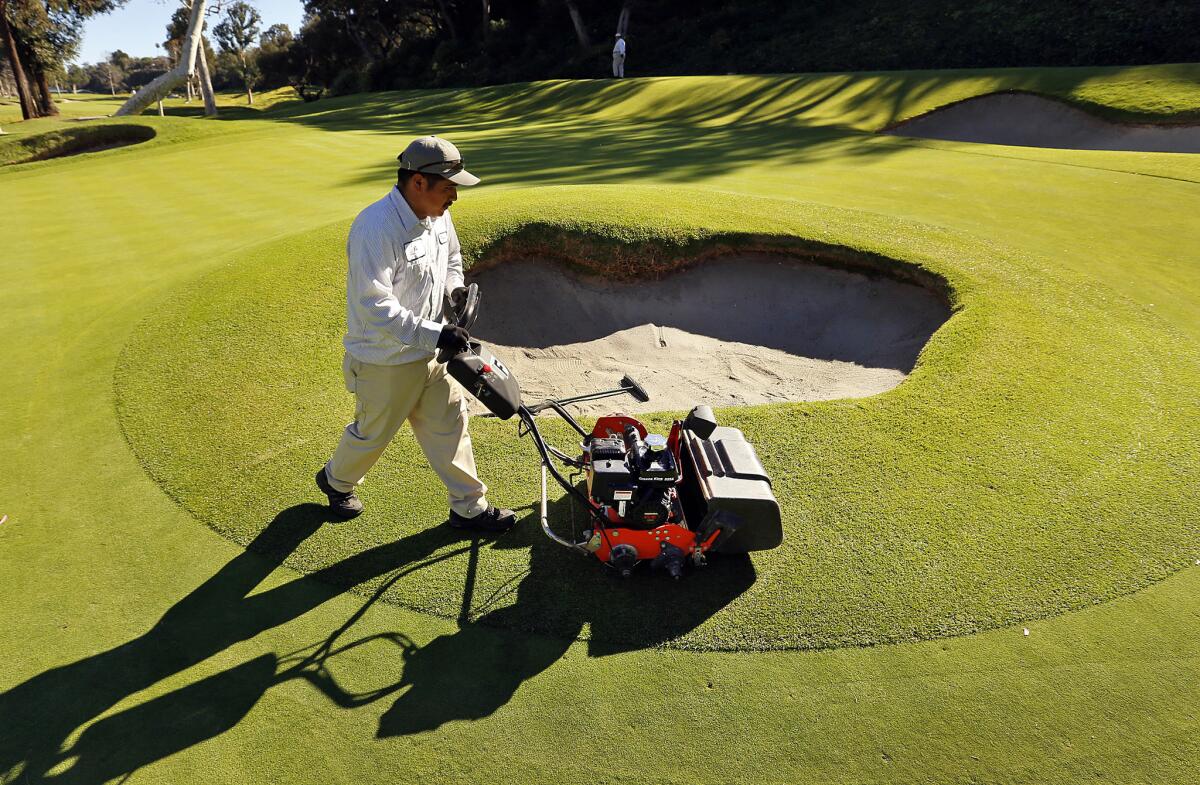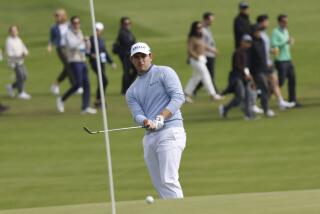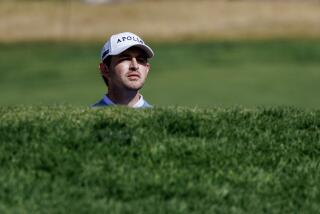Great Read: PGA Tour advance man adds difficulty and drama to Riviera course

Three hundred yards down the fairway, Steve Rintoul stops his golf cart and hops out for a closer look.
Faint lines show in the grass where mowers have recently passed through. Rintoul kneels to run his hand over the short, bristling surface.
“Pure kikuyu,” he says.
The subject of turf varieties can start calculations — launch angles, spin rates — fluttering through his head. Rintoul tries to imagine the world’s best golfers hitting tee shots on this first hole at Riviera Country Club.
How hard will the ball bounce on kikuyu? How far will it run across this stuff that grows in a tight, sticky weave?
“This is like Bermuda grass on steroids,” he says.
As an advance man for the PGA Tour, Rintoul arrives at tournaments early to oversee the transformation of regular courses into something that can challenge the likes of Bubba Watson, Jim Furyk and Sergio Garcia.
The length of Riviera’s first hole — about 500 yards — influences his strategy. If big hitters can pound long drives here, he must find a way to make par more demanding.
Gesturing toward the not-so-distant green, he muses about creating a more difficult second shot by shifting the hole closer to a bunker. Or he could mow that green a fraction of an inch shorter so bold approaches skitter right off.
Not that Rintoul wants to make Riviera unbeatable, but it shouldn’t be easy.
“We’re dealing with the top 1% of golfers,” he says. “You want to test every skill in their bag.”
::
For the better part of two weeks, quiet mornings in Santa Monica Canyon have given way to a steady buzz of mowers and weed whackers and chainsaws used to shape rows of eucalyptus trees.
Crews have raked sand and plucked weeds by hand, preparing for the start of the Northern Trust Open on Thursday. Rintoul, 50, has scooted around in his cart, monitoring their progress.
“Every day,” he says, “we’re tightening things up.”
Though some fans love to watch the pros struggle, difficulty is only part of the formula. Rintoul wants the course to look good on television and, more important, to foster drama.
As often as possible — on tees, fairways and greens — golfers should face risk/reward scenarios, meaning they can play it safe or try for a lower score with a more dangerous shot.
Two weeks doesn’t leave time for moving bunkers or adding rough, but Rintoul can encourage intense moments with small adjustments.
Tee location can funnel shots into problematic stretches of the fairway. Pin placement — moving the hole to different parts of the green — can also make a difference.
After a practice round, Garcia refers to the retooled Riviera as “the kind of course that is asking you to hit the proper shots.”
The Australian-born Rintoul knows this from his time as a Tour player in the mid-1990s. Now, in his 17th season as an official, he begins his work with a purposeful stroll over 18 holes.
“I want to feel what the players are going to feel,” he says. “I want to see what they’re looking at.”
The mental aspect of the game is crucial to putting on a good show.
“It’s about really making the players work and think,” says Geoff Shackelford, author of “The Golden Age of Golf Design.” “That’s exciting.”
::
Mowers usually roll across a given Riviera fairway about three times a week. For the Northern Trust Open, that regimen has been boosted to twice daily.
Crouching down to feel the grass, Rintoul checks for a smooth, even surface.
“We want to clean up every imperfection,” he says. “Every blade of grass.”
The game becomes more entertaining when a well-struck drive flies, hops and rolls for big yardage. As Riviera’s superintendent Matt Morton says: “People stop watching when the ball stops moving.”
Still, bad swings should be penalized. If the rough at Riviera were Bermuda grass, Rintoul might let it grow to four inches. He is aiming for less than three inches with the kikuyu, which tends to grab at the club head.
“It’s like hitting off a Brillo pad,” he says.
On the greens, a mix of bentgrass and poa annua is far smoother but requires no less attention. The putting surface should be as firm and fast as a pool table.
Workers continually check ground moisture with a device that resembles a giant barbecue fork. They drop a metal ball from six feet and measure the indentation to ensure proper hardness.
When Rintoul arrived at work one morning last week, his staff agronomist, Jay Sporl, warned him that hot, dry winds had blown all night. They would have to increase their watering to keep the greens on schedule.
“We don’t want them to be too fast and have to back off,” Rintoul says. “We want to slowly work them to their peak.”
The ultimate measurement involves something called a Stimpmeter, which is really just a short rail that, when tilted to 21 degrees, sends a golf ball gently rolling across the ground.
Testing a green, Sporl measures how many feet the ball travels before stopping. The average country club tries for a Stimpmeter reading of 10 to 11 feet. The Tour prefers a more challenging 12 to 13.
That might not seem like a big difference in speed until you stand over a downhill putt that breaks right to left with $300,000 in prize money at stake.
Riviera’s undulating greens also force Rintoul to take care with pin placement, looking for flat spots, avoiding any slope of more than 2%. He doesn’t want a miniature golf scene with an uphill putt stopping and rolling back to the player’s feet.
“In my business, we call that a ‘career wrecker,’” he says. “You might not work again.”
::
Earlier this month, at the Farmers Insurance Open, Rintoul challenged the field with tall rough and difficult angles to the pin.
The tournament at scenic Torrey Pines was a success in that it ended with a tense, four-man playoff. To no one’s surprise, the winner praised the setup.
“I really enjoy grinding it out and working really hard and stressing over stuff,” Jason Day said.
But the course also prompted cautious play.
J.B. Holmes reached the last hole in regulation with a chance to win if he made birdie. Several players before him had aimed for the pin with their second shot and missed; Holmes chose to lay up short and leave an easier wedge to the green, which resulted in a par.
Later, on the final playoff hole, the tee placement at No. 16 did not suit his eye.
“It’s really just a bad hole,” he said.
Normally a fan of Rintoul’s work, Shackelford also questioned the setup, saying it deprived fans of the spectacular shots — and misses — they crave on Sunday afternoons.
“That one erred on the side of being too hard,” he said of Torrey Pines. “It was all risk and not a lot of reward, which isn’t very compelling.”
On the other hand, the Pebble Beach event last week was won in perfect conditions by Brandt Snedeker with a record score of 22 under par.
Criticism doesn’t seem to faze Rintoul. It won’t surprise him to hear a few more grumbles among the field of 144 this week.
“They all have an opinion,” he says.
::
Within days of the first round, a dozen more Tour competition staff — rules officials, scorers, a meteorologist — arrive at Riviera, a private club situated between Brentwood and Pacific Palisades. The course has progressed far enough for Rintoul to fuss over details.
On the hillside No. 5 tee box, he spots a few branches impinging on the view of the fairway below. At No. 6, famous for its small bunker in the middle of the green, he rolls a couple of balls to check the speed and break.
One ball curves directly toward the trap but stops on a collar of slightly raised grass encircling the sand. The pros will not get any such breaks.
“We’ll give it a last haircut,” Rintoul says. “That ball will roll in.”
When play begins, tee and pin locations will change daily, giving the holes a different look for each round. These movements must be coordinated — a new tee location that favors a drive down the left side might prompt shifting the hole to a part of the green accessible from that area.
Pace is also a consideration. With all of the golfers playing the first two rounds, Rintoul must keep them moving swiftly enough to finish before dark. That’s usually a problem, with the last tee times at 1:15. After the field narrows by roughly half on Friday, he can make things a little thornier.
Sunday’s setup should encourage some of those dramatic risk/reward shots as the leaders play their way to Riviera’s 18th hole with its green set below a Spanish-style clubhouse.
“This place is a classic,” Rintoul says. “It takes you back to the 1920s.”
As soon as the last putt drops, his thoughts will turn to the next Tour stop in Florida. As he flies east Monday, the members at Riviera will be teeing off, eager to see what kind of course the pros play.
They won’t have long to find out. The greens will grow out and the fairways will return to normal. Rintoul’s handiwork will vanish in a couple of days.
Follow David Wharton on Twitter @LATimesWharton
More to Read
Get our high school sports newsletter
Prep Rally is devoted to the SoCal high school sports experience, bringing you scores, stories and a behind-the-scenes look at what makes prep sports so popular.
You may occasionally receive promotional content from the Los Angeles Times.







